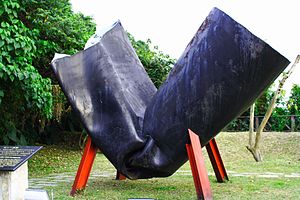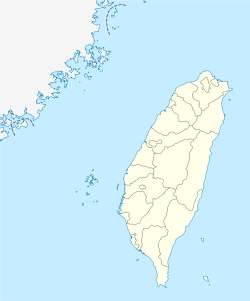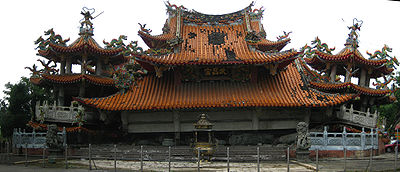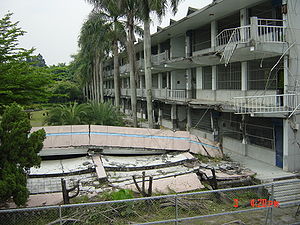- 921 earthquake
-
For the September 21, 2009 earthquake in Bhutan, see 2009 Bhutan earthquake.
1999 Jiji Earthquake
(921 Earthquake)
Date 01:47:12, September 21, 1999 Magnitude 7.6 Mw / 7.3 Ms Depth 8.0 km (5.0 mi) Epicenter 23°46′19″N 120°58′55″E / 23.772°N 120.982°E
Jiji, Nantou, Taiwan.Countries or regions  Republic of China (Taiwan)
Republic of China (Taiwan)Casualties 2,415 killed
29 missing
11,305 injured
51,711 buildings destroyed
53,768 buildings damagedThe 921 earthquake (Chinese: 九二一大地震; pinyin: Jiǔ'èryī dàdìzhèn), also known as Jiji earthquake (Chinese: 集集大地震; pinyin: Jíjí dàdìzhèn), was a 7.3 Ms or 7.6 Mw earthquake which occurred at 1:47:12 am local time (17:47:12 UTC on September 20, 1999) in Jiji (Chichi, 集集), Nantou County, Taiwan. 2,415 people were killed, 11,305 injured, and NT$300 billion (US$10 billion) worth of damage was done. It was the second-deadliest quake in recorded history in Taiwan, after the 1935 Hsinchu-Taichung earthquake.
Rescue groups from around the world joined local relief workers and the ROC military in digging out survivors, clearing rubble, restoring essential services and distributing food and other aid to the more than 100,000 people made homeless by the quake. The disaster, dubbed the "Quake of the Century" by local media, had a profound effect on the economy of the island and the consciousness of the people, and dissatisfaction with government's performance in reacting to it was said by some commentators[who?] to be a factor in the unseating of the ruling Kuomintang party in the 2000 Presidential Election.
Contents
Technical data
The earthquake struck at 1:47:12 a.m. (Taiwan Time) on Tuesday, September 21, 1999 (i.e., 1999-09-21, hence "921"). The epicentre was at 23.77° N latitude, 120.98° E longitude, 9.2 km (5.7 mi) southwest of Sun Moon Lake, near the town of Jiji, Nantou. The tremor measured 7.6 on the Moment magnitude scale, 7.3 on the Richter scale, and the focal depth was 8.0 km (5.0 mi). The Central Weather Bureau recorded a total of 12,911 aftershocks in the month following the main tremor.[1] The earthquake was in an unusual location for Taiwan, which experiences the majority of its earthquakes off the eastern coast, such quakes normally causing little damage.[2] One of the aftershocks, on September 26, was a strong earthquake in its own right, measuring 6.8 on the Richter scale and causing some already weakened buildings to collapse, killing another three people.[3]
Due to an extensive network of sensors and monitoring stations, the quake was the best recorded and analysed large quake in history. At one station, a peak ground motion of 300 cm/s (3 m/s; 10 ft/s) was recorded, the highest ever measurement taken in an earthquake anywhere.[2] Soil liquefaction was observed at Yuanlin and caused settlement of building foundations and filling in of water wells from sand boils.[2] The earthquake occurred along the Chelongpu Fault (Chinese: 車籠埔斷層; pinyin: Chēlóngpǔ duàncéng) in the western part of the island of Taiwan. The fault stretches along the foothills of the Central Mountains in Nantou County and Taichung County (now part of Taichung City). Some sections of land near the fault were raised as much as 7 m (23 ft). Near Dongshih, near the northern end of the fault, a 7 m (23 ft) high waterfall was created by the earthquake.[citation needed]
Damage
Damage caused by the earthquake included 2,415 deaths, 29 missing, 11,305 severely wounded, with 51,711 buildings completely destroyed, 53,768 buildings severely damaged, and a total of NT$300 billion (US$10 billion) worth of damage.[4] Power was cut to a large proportion of the island, due to damage to power stations, transmission stations, and the automatic shutdown of Taiwan's three nuclear power plants, which were restarted two days later.[5] National electricity provider Taipower stated that a day after the quake power had been restored to 69% of the country.[6] 102 major bridges were badly damaged, with many having to be torn down.[7] The Central Cross-Island Highway, at the time the only major complete route across the mountains in central Taiwan, was badly damaged. Subsequent storm damage and the high cost of restoration means that the highway remains closed as of 2009 and is not expected to be reopened. There were a total of 132 landslides during the main quake and the aftershocks, some causing loss of life as rockfalls crushed houses.[8] 870 schools suffered damage, with 125 severely damaged, closing many down for months or even permanently in a few cases.[9]
Central Taiwan
The effects of the earthquake were most severe in central Taiwan, particularly in Nantou County and Taichung County. Towns such as Puli suffered huge damage, and the majority of the casualties were concentrated in these regions. Due to the relatively remote location of many of the affected settlements, aid from the central government took some time to reach some survivors. The Port of Taichung (台中港), one of Taiwan's major commercial harbours, was badly damaged and had to be temporarily closed down.[10]
Northern Taiwan
In Taipei City, far from the epicentre of the quake, buildings were shaken, but just one, the 12 stories Tunghsing Building (Chinese: 東星大樓; pinyin: Dōngxīng Dàlóu), collapsed as a result of the tremor. 87 people died in the rubble of the building, which was later found to be unsoundly built, with structural pillars and beams stuffed with plastic bottles and newspaper instead of brick and concrete.[11] Blame for the collapse was levelled by survivors at both the construction company which built the high-rise and local government for lax enforcement of building codes and safety standards. Five people were indicted in the wake of the disaster.[11]
Economic damage
The Taiwan Stock Exchange was closed for business for five days following the earthquake.[12] A significant proportion of the world supply of RAM was at the time made in Taiwan, and the six-day shutdown of Hsinchu Science Park and other factories resulting from the quake caused computer memory prices to triple on world markets.[13] With Taiwan struggling to recover from the after-effects of the 1997 Asian Financial Crisis, the economic damage of the earthquake was a great cause for concern, with estimates that the total cost would be some 10% of the entire gross domestic product of the country in 1999.
Causes of building collapse and public reaction
The immediate rescue efforts were still ongoing when public anger began to mount at shoddy construction that many felt was responsible for the high number of casualties. Legal building codes, enforcement of those codes, and the construction companies themselves all came in for criticism. Builders and architects of modern buildings which collapsed were detained by authorities, and their assets and travel documents frozen.[14] One of the issues highlighted after the quake was "soft stories": high, open ground floors in high-rise buildings with little structural support. This led to the ground floor collapsing first in a quake, either toppling the other floors or starting a pancake collapse.[2] Buildings in Taiwan over 50m tall require a peer review process, and significantly no building that had undergone this process collapsed, contrasting with a number of dramatic failures of buildings just under 50m in height.[2]
International response
There was widespread international sympathy for those affected by the earthquake, and over 700 rescue workers from more than 20 countries aided in the immediate aftermath.[15] Initially Taiwan's isolated diplomatic situation caused a delay in a response from the United Nations, which recognises the People's Republic of China as the legitimate government of the island, and so could not act without the approval of the Beijing government.[16]
 Japan: US$500,000 in aid was pledged by the Japanese government, along with more than 100 rescue workers. Prime Minister Keizo Obuchi offered his condolences on behalf of the Japanese people.[16]
Japan: US$500,000 in aid was pledged by the Japanese government, along with more than 100 rescue workers. Prime Minister Keizo Obuchi offered his condolences on behalf of the Japanese people.[16] France: President Jacques Chirac "addressed a message of sincere sympathy and condolences to all the victims of this catastrophe and their families. France is following the situation closely and is ready to provide the Taiwanese people with the support and emergency aid they may need."[16]
France: President Jacques Chirac "addressed a message of sincere sympathy and condolences to all the victims of this catastrophe and their families. France is following the situation closely and is ready to provide the Taiwanese people with the support and emergency aid they may need."[16] Germany: Chancellor Gerhard Schröder spoke of his "deep compassion to the quake victims and their families".[16]
Germany: Chancellor Gerhard Schröder spoke of his "deep compassion to the quake victims and their families".[16] Mexico: The Mexican team of rescue workers was involved in tackling the Tunghsing Building collapse and earned widespread praise for their skill and commitment.[15]
Mexico: The Mexican team of rescue workers was involved in tackling the Tunghsing Building collapse and earned widespread praise for their skill and commitment.[15] Russia: A team of 76 rescue workers was dispatched by the Emergency Situations Ministry to help with the search and rescue efforts.[16]
Russia: A team of 76 rescue workers was dispatched by the Emergency Situations Ministry to help with the search and rescue efforts.[16] Canada: A 5 member volunteer Search and Rescue team from Abbotsford British Columbia, under the umbrella of a private company, and supported by the local Taiwanese community, provided Search and Rescue services for 96 hrs.
Canada: A 5 member volunteer Search and Rescue team from Abbotsford British Columbia, under the umbrella of a private company, and supported by the local Taiwanese community, provided Search and Rescue services for 96 hrs. Turkey: Having been hit by a devastating earthquake just the previous month, Turkish NGOs had recent experience in search and rescue operations. A 15-person team from Turkey left for Taiwan within hours of news of the quake being received.[16]
Turkey: Having been hit by a devastating earthquake just the previous month, Turkish NGOs had recent experience in search and rescue operations. A 15-person team from Turkey left for Taiwan within hours of news of the quake being received.[16] United Kingdom: Condolences were offered by Elizabeth II, who in a statement said "The Queen was greatly saddened to learn of the terrible earthquake in Taiwan and the consequent tragic loss of life." A relief team of six people from Rapid UK, a disaster rescue group, was dispatched to help search for trapped survivors.[17]
United Kingdom: Condolences were offered by Elizabeth II, who in a statement said "The Queen was greatly saddened to learn of the terrible earthquake in Taiwan and the consequent tragic loss of life." A relief team of six people from Rapid UK, a disaster rescue group, was dispatched to help search for trapped survivors.[17] United States: President Bill Clinton issued a statement, saying that "our thoughts are with all of those who have suffered losses and who may still be in need of assistance", while also pledging aid to assist in disaster recovery. Despite the lack of official diplomatic relations with Taiwan, US authorities liaised directly with their Taiwanese counterparts, and sent a 85-person team to assist in the aftermath.[16]
United States: President Bill Clinton issued a statement, saying that "our thoughts are with all of those who have suffered losses and who may still be in need of assistance", while also pledging aid to assist in disaster recovery. Despite the lack of official diplomatic relations with Taiwan, US authorities liaised directly with their Taiwanese counterparts, and sent a 85-person team to assist in the aftermath.[16] South Korea:In addition to the cash grant, the Korea International Search and Rescue Team(Chief Commander Park, Chung Wung) was deployed to the affected site for 2 weeks, and during the operation, the team dramatically rescued a 6 year old boy who simultaneously lost both parents and his younger sister due to the building collapse caused by the earthquake. The boy unbelievably sustained his life for 84 hours without external assistance such as water and food.
South Korea:In addition to the cash grant, the Korea International Search and Rescue Team(Chief Commander Park, Chung Wung) was deployed to the affected site for 2 weeks, and during the operation, the team dramatically rescued a 6 year old boy who simultaneously lost both parents and his younger sister due to the building collapse caused by the earthquake. The boy unbelievably sustained his life for 84 hours without external assistance such as water and food. Vatican City: Pope John-Paul II expressed his concern in his Angelus of September 26, remarking that "at these days my thoughts have constantly turned to the beloved people of Taiwan as they recover from the recent quake and its devastating aftermath".[15]
Vatican City: Pope John-Paul II expressed his concern in his Angelus of September 26, remarking that "at these days my thoughts have constantly turned to the beloved people of Taiwan as they recover from the recent quake and its devastating aftermath".[15] People's Republic of China: Relations between the two sides had been particularly strained shortly before the earthquake, with tensions high over the impending presidential elections in Taiwan. Chinese President Jiang Zemin sparked hope of an improvement in relations when he expressed the sorrow of mainland Chinese at news of the disaster, and stated that "we are willing to offer any possible assistance to alleviate quake-caused losses."[16] Jiang went on to say that "Compatriots of the two sides are as closely linked as flesh and blood. The catastrophe and agony of our Taiwan compatriots influences the hearts of all Chinese."[18] However, after a few days the Taipei government was accusing Beijing of exploiting the earthquake for political ends and preventing speedy assistance from the international community getting to those in need. A Russian flight carrying search and rescue personnel was refused permission to cross Chinese airspace, and the PRC insisted that any approaches to send aid to Taiwan from other nations needed the blessing of the Beijing government first, slowing the arrival of international help.[19]
People's Republic of China: Relations between the two sides had been particularly strained shortly before the earthquake, with tensions high over the impending presidential elections in Taiwan. Chinese President Jiang Zemin sparked hope of an improvement in relations when he expressed the sorrow of mainland Chinese at news of the disaster, and stated that "we are willing to offer any possible assistance to alleviate quake-caused losses."[16] Jiang went on to say that "Compatriots of the two sides are as closely linked as flesh and blood. The catastrophe and agony of our Taiwan compatriots influences the hearts of all Chinese."[18] However, after a few days the Taipei government was accusing Beijing of exploiting the earthquake for political ends and preventing speedy assistance from the international community getting to those in need. A Russian flight carrying search and rescue personnel was refused permission to cross Chinese airspace, and the PRC insisted that any approaches to send aid to Taiwan from other nations needed the blessing of the Beijing government first, slowing the arrival of international help.[19]
Rescue efforts
Immediately following the earthquake an emergency cabinet meeting was convened to discuss how to tackle the aftermath. The same day the ROC military was mobilised, with large numbers of conscripted soldiers heading to stricken regions to assist in distributing emergency supplies, clearing roads, and rescuing people trapped in the rubble. Helicopters were used to evacuate injured people from mountainous regions to hospitals, and to supply food to communities inaccessible by road.[20] The military also assumed the leading role in recovering the dead from damaged structures.[2]
One of the last people to be rescued was a six year old boy pulled alive from the rubble of his collapsed home in Taichung County by a team of South Korean and Japanese search and rescue workers, some 88 hours after the quake.[21] Even later, nearly 130 hours after the earthquake, two brothers emerged alive from the ruins of the Tunghsing Building in Taipei to the astonishment of rescuers. The brothers survived on the water sprayed from fire hoses, rotten fruit, and their own urine.[22]
Clean-up and reconstruction
On September 25 President Lee Teng-hui declared a state of emergency in the affected areas, giving sweeping powers to local authorities to ignore the usual bureaucratic and legal restrictions on measures to bring relief to people and locations most in need. This was the first time emergency powers had been used since the death of former President Chiang Ching-kuo in 1989.[23]
Many charities, corporations, and private individuals contributed to the relief effort and the later reconstruction. Private donations directly to the government-run disaster fund totalled NT$33.9bn,[24] while organisations including the Presbyterian Church of Taiwan, Rotary International, Cathay Life Insurance, Dharma Drum Mountain, I-Kuan Tao, the Tzu Chi Foundation and various temple, church, and community groups all contributed to aiding survivors and funding reconstruction.[25] The Church of Jesus Christ of Latter-day Saints provided both direct relief and translation services for the foreign rescue teams,[26] while the Red Cross of the People's Republic of China contributed US$3m to the Republic of China Red Cross, which amassed a fund of NT$1.8bn towards disaster relief.[27]
Following the election of Chen Shui-bian, the reconstruction policies were continued despite the change in ruling party. Chen said in his inaugural address in May 2000 that "our people experienced an unprecedented catastrophe last year, and the wounds are yet to be healed. The new cabinet feels that restoration cannot be delayed. [...] Reconstruction has to cover every victim and every earthquake-affected area."[28]
One task that had to be undertaken was the setting of new land ownership boundaries in areas where the landscape had been significantly altered by the quake. The whole island was elongated about 1.5m in the north-south axis and compressed west-east by the forces unleashed. One solution offered to land issues was to offer landowners an equivalent parcel of government land not located on a fault line.[29]
Legacy
 Waterworks pipe bent by the earthquake, 2 meters (7 ft) in width and 1.8 cm (0.7 inches) in thickness, originally underground in Fengyuan, Taichung County, exhibited at the Museum of Drinking Water, Zhongzheng District, Taipei
Waterworks pipe bent by the earthquake, 2 meters (7 ft) in width and 1.8 cm (0.7 inches) in thickness, originally underground in Fengyuan, Taichung County, exhibited at the Museum of Drinking Water, Zhongzheng District, Taipei
The quake has become part of the Taiwanese consciousness, and is often referred to simply as 921 (Chinese: 九二一; pinyin: Jiǔ'èryī) after the date it occurred (September 21). Unhappiness with the government's performance in response to the disaster was reflected in a drop in support for vice-president Lien Chan who was standing as the Kuomintang candidate for the 2000 presidential elections.[30]
In Wufeng, a township in southern Taichung County, the damage was especially devastating; the village's Guangfu Junior High School lay directly on the fault line and was severely damaged by the quake. Today the junior high school is the site of the National Museum of Natural Science's 921 Earthquake Museum.[1]
The tenth anniversary of the earthquake in 2009 was marked by commemorative activities in some of the areas affected. Taipei, Dongshi, Wufeng, Puli, Jiji and Zhongxing Xincun held various events to remember the victims of the earthquake, the rescuers who aided them, and the reconstruction efforts which followed.[31]
See also
- List of earthquakes in Taiwan
- List of 20th-century earthquakes
- List of deadly earthquakes since 1900
- National Center for Research on Earthquake Engineering (NCREE)
- John Walker, Chi-Chi earthquake benefit concerts
- 921 Earthquake Museum of Taiwan
External links
Notes
- ^ a b Edmonds and Goldstein, p.17.
- ^ a b c d e f "The Chi-Chi, Taiwan Earthquake of September 21, 1999". Earthquake Engineering Research Institute. 1999–12. http://www.eeri.org/lfe/pdf/taiwan_chi_chi_eeri_preliminary_report.pdf.
- ^ "Fierce aftershock raises death toll". Taipei Times. 1999-09-27. http://www.taipeitimes.com/News/front/archives/1999/09/27/4161.
- ^ According to the National Fire Agency, Ministry of the Interior R.O.C
- ^ "Nuclear Power Plants and Earthquakes". World Nuclear Association. http://www.world-nuclear.org/info/inf18.html.
- ^ "Quake of the century". September 22, 2009. http://www.taipeitimes.com/News/front/archives/1999/09/22/3502.
- ^ Experiences, p.1.
- ^ Experiences, p.6.
- ^ Experiences, p.7.
- ^ "Infrastructure dealt a crippling blow". Taipei Times. September 22, 1999. http://www.taipeitimes.com/News/quake/archives/1999/09/22/3506.
- ^ a b "Taipei government ordered to pay quake victims 13.8 mln US dollars". Relief Web. April 29, 2002. http://www.reliefweb.int/rw/rwb.nsf/db900sid/ACOS-64CBX6?OpenDocument.
- ^ "The tragedy unfolds". Taipei Times. September 23, 1999. http://www.taipeitimes.com/News/front/archives/1999/09/23/3634.
- ^ "Chip shortage raises computer prices". The Victoria Advocate. October 15, 1999. http://news.google.com/newspapers?nid=861&dat=19991015&id=FiYPAAAAIBAJ&sjid=RYUDAAAAIBAJ&pg=6712,3123228.
- ^ "Building firms under investigation". Taipei Times. September 26, 1999. http://www.taipeitimes.com/News/front/archives/1999/09/26/4034.
- ^ a b c Chang, Frank (October 1, 1999). "Rescue; Relief aid and search teams pour into Taiwan in quake's aftermath". Taiwan Today. http://74.125.153.132/search?q=cache:IRXMAJTiyUUJ:taiwanjournal.nat.gov.tw/ct.asp%3FxItem%3D17514%26CtNode%3D122.
- ^ a b c d e f g h Chen, Lauren (September 22, 1999). "World leaders express their condolences". Taipei Times. http://www.taipeitimes.com/News/react/archives/1999/09/22/3512.
- ^ "Queen's sympathy for quake victims". BBC. September 22, 1999. http://news.bbc.co.uk/2/hi/uk_news/454489.stm.
- ^ "Massive earthquake jolts Taiwan; at least 1,100 killed". CNN. September 21, 1999. http://www-cgi.cnn.com/ASIANOW/east/9909/20/taiwan.quake.04/.
- ^ Lin, Irene (September 25, 1999). "Taipei accuses China of exploiting quake". Taipei Times. http://www.taipeitimes.com/News/front/archives/1999/09/25/3912.
- ^ "Rescue workers struggling with shortages as military moves in to disaster areas". Taipei Times. September 22, 1999. http://www.taipeitimes.com/News/rescue/archives/1999/09/22/3510.
- ^ "Hoping against the odds". Taipei Times. September 25, 1999. http://www.taipeitimes.com/News/front/archives/1999/09/25/3913.
- ^ Chu, Monique (September 27, 1999). "Tunghsing rescue arouses hope". Taipei Times. http://www.taipeitimes.com/News/front/archives/1999/09/27/4163.
- ^ Chen, Lauren (September 26, 2009). "President Lee announces emergency decree". Taipei Times. http://www.taipeitimes.com/News/front/archives/1999/09/26/4033.
- ^ Experiences, p.20.
- ^ Experiences, pp.640–704.
- ^ Experiences, p.643.
- ^ Experiences, p.625.
- ^ Experiences, p.24.
- ^ Edmonds and Goldstein, pp.14–15.
- ^ Edmonds and Goldstein, p.16.
- ^ Kao, Y.L. (July 2, 2009). "Cabinet to hold 921 earthquake commemorative activities: official". China Post. http://www.chinapost.com.tw/taiwan/national/national-news/2009/07/02/214674/Cabinet-to.htm.
References
- Experiences on Post-disaster Reconstruction for the 921 Earthquake. Taiwan Historica. 2006. ISBN 978-986-00-7233-4.
- Edmonds, Richard L.; Goldstein, Steven M. (2001). Taiwan in the Twentieth Century: A Retrospective View. Cambridge University Press. ISBN 978-0521003438.
← Earthquakes in 1999 → Earthquakes in Taiwan Earthquakes 1904 Douliu · 1906 Meishan · 1916-17 Nantou · 1935 Hsinchu-Taichung · 1941 Chungpu · 1946 Hsinhua · 1951 East Rift Valley · 1959 Hengchun · 1964 Baihe · 1966 Hualien · 1972 Ruisui · 1994 Taiwan Strait · 1999 Jiji ("921") · 2006 Hengchun · 2009 Hualien · 2010 KaohsiungOrganisations Categories:- Earthquakes in Taiwan
- 1999 earthquakes
- 1999 in Taiwan
Wikimedia Foundation. 2010.



